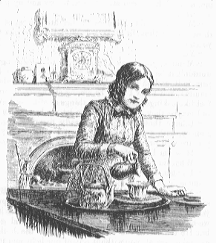|
|
|
Domesticity & Domestic Literature [domestic < Latin domus, house] |
Domestic literature expresses affection for the home and for family values, relations, and identities.
Domestic and sentimental literature was popular in the American Renaissance, esp. among the growing audience of women readers of fiction and self-help books (including housekeeping and cooking manuals). Men also read and wrote domestic literature but frequently reacted against its popularity in hopes of a more serious or "manly" national literature. This critical reaction continued in male-dominant English departments through most of the 20th century, but rising generations of post-liberation women and men increasingly respect domestic literature, as scholarship has reprinted forgotten writings and contextualized them as serious expressions of women's and families' hopes and realities in changing times.
Critical reception of domestic and sentimental literature remains mixed, but here are some starting points:
Domestic refers to home or family life (as today:
domestic partnerships; domestic violence;
Genres: Domestic literature includes women's magazines, home economics (a.k.a. domestic science), advice, humor, true life stories, and fiction that is often sentimental or didactic.
Sentimental and domestic literature often overlap or are used as synonyms.

